|
The KT66 is widely regarded as the finest audio valve ever designed, however, for the 10 Watt class the 6V6 family is hard to beat.
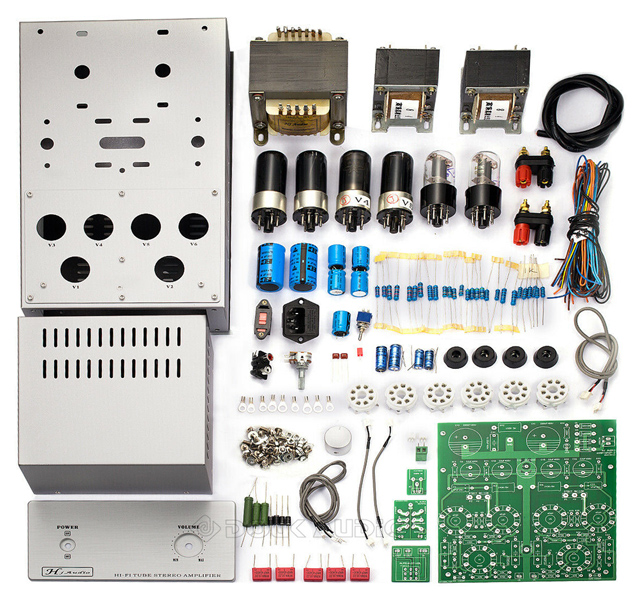
The amplifier Kit as advertised on ebay.
The author has plans for a pair of mono-bloc 6V6 push pull amplifiers with Hammond output transformers and DC-DC converts for both heater supply and main HT - all powered from a 19.5 Volt 'laptop brick' switched mode power supply. While looking at ebay, the present amplifier kit caught the author's eye. Several other Chinese single ended kits had been made but this was Class AB1 push pull and more expensive than the others.
The kit is very heavy and came excellently packed. Nothing was damaged in transit. The amplifier has a brushed aluminium front paned and exposed valves. The three transformers have tag connections and are concealed under a box at the rear of the case. The appearance is semi-industrial and the author's wife was not prepared to offer it a place in a domestic setting.
The first impression when the kit was unpacked was that it was far more professional than the other kits from the same supplier. The signal leads were ready made with connectors for the circuit boards. Some connectors were push fit into sockets on the board and others were push through into the circuit board holes and soldered in place.
The three transformers were designed to fit onto the chassis with the laminations all in the same direction. Accepted practice is to mount the mains transformer at right angles to the output transformers to minimise hum pick-up. In mounting the rotated mains transformer the chassis holes were covered. It was found that 1 mm thick washers placed between the transformer feet and the chassis allowed access to the holes and did not require a change of mounting hardware.
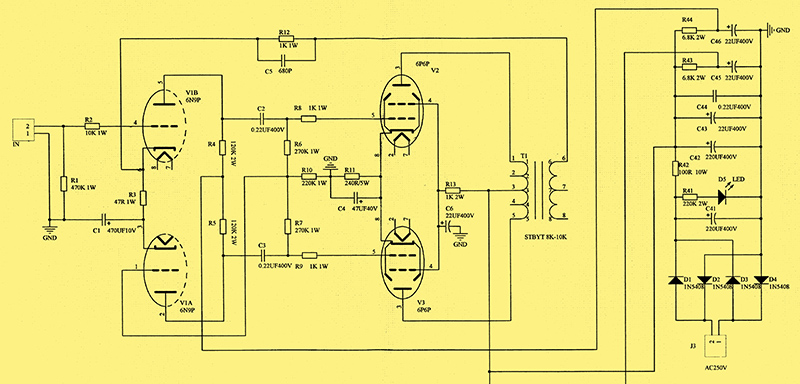
The circuit of one channel and power supply.
In addition to the main circuit board, there were boards for the input connectors, output impedance switch and volume control. All made to high standards with legends clearly printed. The supplied documentation was a two-sided circuit diagram and a component list. Downloaded the image of the underside of a completed amplifier was helpful. Although this kit was a delight to build it is not for the novice.
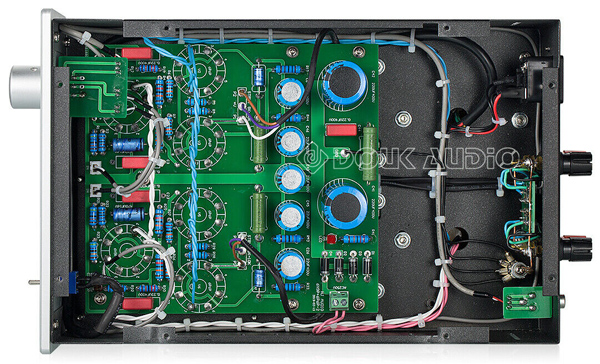
The underside of the amplifier - ebay image.
Wiring up the boards was a joy. The only niggle was that the feedback capacitor was too small for the holes provided. Mounting the capacitor at an angle and using the feedback lead hole for the capacitor and the capacitor hole for the lead solved the problem. The supplied picture shows the heater twisted wiring on the component side of the board. The author placed the heater wiring on the valve-holder side for a more pleasing visual appearance.
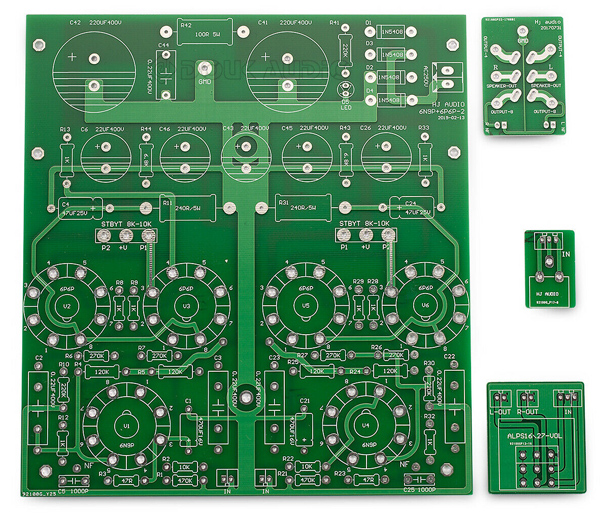
The set of double sided plated through circuit boards.
Working slowly the author needed less than a morning to complete the boards. Wiring the transformers etc. was a significantly longer job. Extensive use was made of cable ties and heat-shrink sleeving - not part of the kit.
Initially the amplifier had power applied briefly to check the HT supply. Next the heater voltages were confirmed to be correct. Finally the 6P6P and 6N9P valves were added and the amplifier switched-on. The valves came in numbered boxes - suggesting that the output valves were matched pairs. All valves had matching black plastic skirts.
As the valves warmed-up a slight hum could be heard from the 8 Ω Mission speakers. Using an on-line speaker test video the left and right channels and speaker phasing was checked. With only one speaker receiving a signal the other speaker was silent. A much better separation than that obtained from the simplex stereo amplifiers.
The valves generate a great deal of heat. The power resistors also need good ventilation and the case/chassis allows for this with a slotted base plate and slotted sides.
Nothing was getting too hot and so the amplifier was tested with various items of music supplied from the desk computer sound-card. The sound was excellent and clearly this was going to perform well on test.
Voltages were measured. The HT rail was at 315 Volts and the screen grids were at 310 Volts - 2.5 mA per valve. The 6P6P cathodes were at 19 Volts. With cathode resistors, per channel, of 240 Ω the valve current, without a signal, was 79 mA per pair. A total dissipation of 23 Watts - below the maximum permissible.
Eight Ohm dummy loads were attached and the two channel oscilloscope connected to display the output. A sine wave from the function generator was fed to both inputs simultaneously. It was decided that the performance should be tested at 1 Watt and then at the maximum before clipping.

The amplifier performance at 1 Watt.
One watt into eight Ohms is a voltage of 2.83 V RMS. The 1 kHz sine wave input from the high impedance output of the function generator was 576 mV pk-pk or 205 mV RMS.

The amplifier performance at 10 Watts - just before the sine wave started to flatten.
Symmetrical flattening of the sine wave was observed with an input of 2.1 V pk-pk corresponding to 0.75 V RMS. The second harmonic was down in the noise and the third harmonic was at - 32 dB. The fourth harmonic was in the noise and the fifth was down at -44 dB. This gives a THD of 3%. The output was measured to be 9.2 V RMS corresponding to 10.6 Watts. Given that sine wave testing a cathode biased amplifier gives a low reading the actual power would be 10% greater or 11.7 Watts. Very close to the advertised power.
The shape of the full power curve is almost flat across the audio range - by far the best performance of any of the Douk Audio amplifiers tested by the author.
Listening tests are always subjective and the author has high frequency hearing loss. Other members of the household commented on the clarity and depth of the sound. The author just placed it as his main amplifier displacing the SE 6P3P on the museum desk.
In May 2020 the amplifier could be purchased ready made for £293.69 with £110.00 postage and packing.
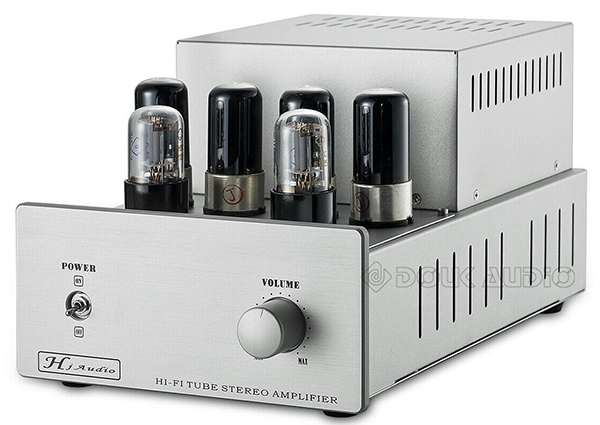
The completed amplifier as advertised on ebay.
|